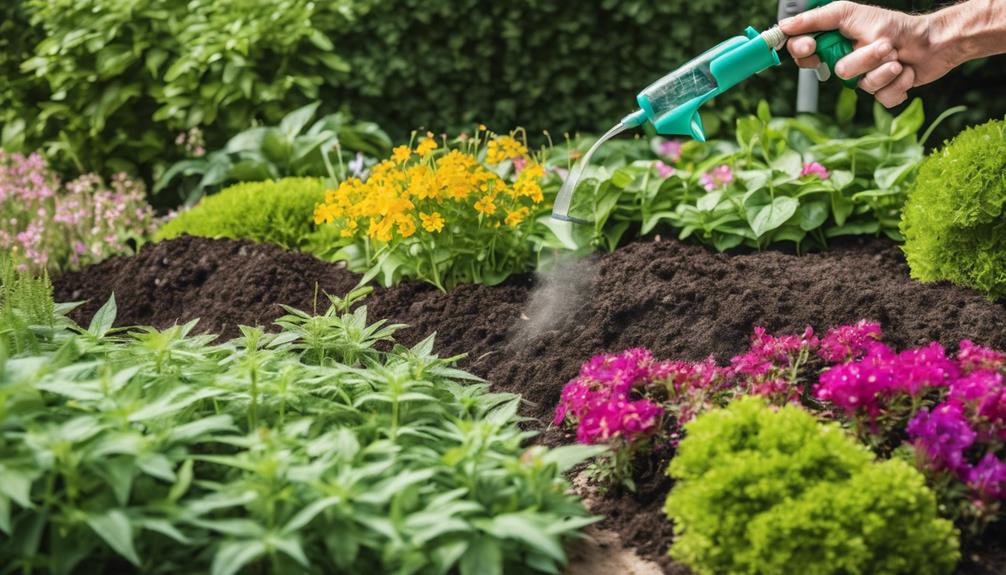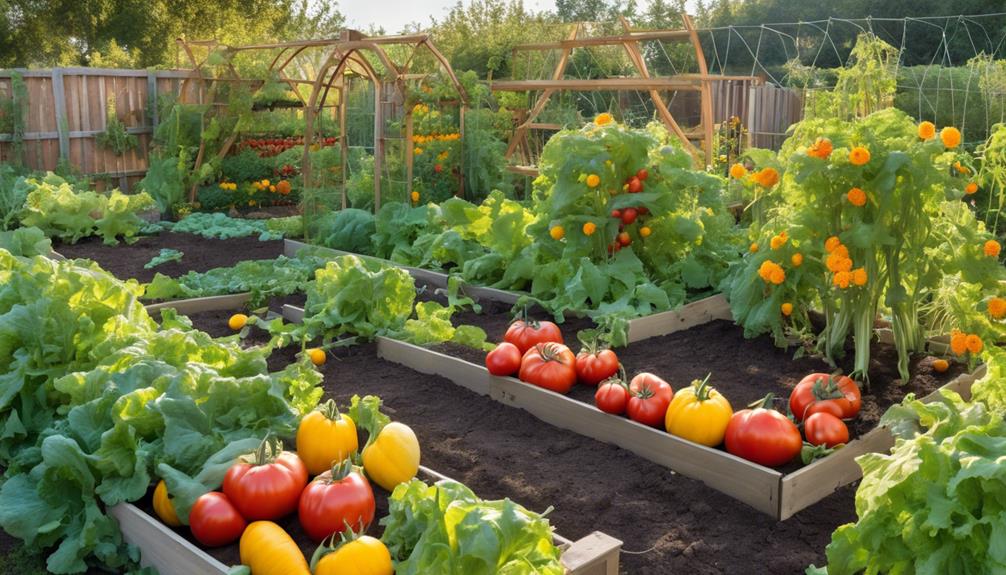
Summer Garden Maintenance Bournville
14 March 2025Why Is Winter Turf Recovery Important?
15 March 2025The best methods for weed control integrate cultural, chemical, and mechanical practices.
Cultural techniques such as crop rotation and the use of cover crops disrupt weed life cycles and promote soil health.
Chemical options like selective herbicides target specific weeds while preserving desired crops.
Mechanical strategies, including mulching and hoeing, physically remove weeds and suppress their growth.
Regular soil testing also aids in effective management by identifying nutrient deficiencies and ensuring optimal growth conditions.
Understanding these diverse strategies will provide a comprehensive approach to weed control while enhancing overall agricultural productivity.
Investigate further to uncover additional effective techniques.
Weed Control Methods Explained
Weed control methods can be broadly categorised into cultural control practices and chemical control options.
Cultural practices focus on modifying the environment to promote desirable plants while suppressing weed growth.
In contrast, chemical options involve the application of herbicides to effectively manage weed populations.
Cultural Control Practices
Implementing cultural control practices is a vital strategy in integrated weed management, focusing on modifying agricultural practices to suppress weed growth effectively.
These practices include crop rotation, which disrupts weed life cycles, and optimal planting dates, allowing competitive crops to establish before weeds.
Moreover, maintaining soil health through proper fertilisation and irrigation can improve crop vigour, further outcompeting weeds.
Employing cover crops can suppress weed germination by providing ground cover and competition for sunlight and nutrients.
In addition, practising adequate tillage methods, such as reduced tillage, can minimise soil disturbance, thereby limiting weed seed germination.
Chemical Control Options
Chemical control options play a crucial role in managing weed populations effectively within agricultural systems. These options typically involve the application of herbicides, which are classified into two main categories: selective and non-selective.
Selective herbicides target specific weed species while sparing desired crops, thereby minimising collateral damage. Non-selective herbicides, on the other hand, eliminate all vegetation in the treated area, making them suitable for site preparation or fallow systems.
The timing, method of application, and choice of herbicide are critical factors influencing efficacy and environmental impact. Integrated approaches, combining chemical control with cultural and mechanical methods, improve overall weed management while reducing reliance on chemical inputs.
Continuous monitoring and adherence to best practices are vital for sustainable chemical weed control.
Weed Growth Patterns
Understanding weed growth patterns is crucial for effective management and control strategies.
Factors such as soil moisture levels, nutrient competition among plants, and variability in root depth greatly influence how weeds establish and proliferate.
Soil Moisture Levels
Soil moisture levels play an important role in shaping weed growth patterns, influencing both germination and establishment. Adequate moisture can create an environment conducive to weed proliferation, whilst insufficient moisture may hinder their development. Understanding these dynamics is vital for effective weed management.
- Germination Rate: Higher soil moisture can improve the germination rates of many weed species, leading to a quicker establishment phase.
- Root Development: Sufficient moisture promotes robust root systems in weeds, enabling them to compete more effectively for resources.
- Species Variation: Different weed species exhibit varying moisture requirements, necessitating tailored management strategies based on specific conditions.
Effective control strategies must consider these moisture dynamics to mitigate the impact of invasive weed populations in agricultural and landscape settings.
Nutrient Competition Among Plants
Moisture levels not only influence weed germination and establishment but also significantly affect nutrient availability in the soil.
The competition for nutrients among plants, including both crops and weeds, is a critical factor determining the success of any weed management strategy. Weeds often exhibit aggressive growth patterns, exploiting nutrient resources that could otherwise support desired plants.
Consequently, understanding the dynamics of nutrient competition is vital for effective weed control. Key considerations include:
- Nutrient uptake efficiency: Weeds frequently outcompete crops for essential nutrients.
- Soil fertility: Elevated nutrient levels can promote rapid weed growth, necessitating proactive management.
- Plant diversity: A diverse crop rotation can mitigate nutrient competition, fostering healthier soil ecosystems.
Addressing these factors can greatly enhance weed control efforts.
Root Depth Variability
Root depth variability among different weed species plays a crucial role in their growth patterns and competitive abilities in agricultural systems. Understanding these differences can inform effective weed management strategies.
Weeds with deeper root systems can access moisture and nutrients unavailable to shallow-rooted crops, leading to increased competition. Key considerations include:
- Root Architecture: The structure and arrangement of roots can influence a weed's ability to thrive under diverse soil conditions.
- Water Utilisation: Deep-rooted weeds may exploit water resources more efficiently, particularly in drought conditions, thereby outcompeting crops.
- Nutrient Absorption: Variability in root depth affects the capacity for nutrient uptake, impacting overall plant health and yield.
Addressing root depth variability is crucial for optimising weed control and enhancing crop productivity.
Soil Testing for Effectiveness
Soil testing is essential for determining the appropriate conditions for effective weed control.
Understanding soil composition can inform practices such as soil preparation fundamentals, mulching for moisture retention, and the application of natural herbicides.
Soil Preparation Essentials
Effective weed control begins with a thorough understanding of the soil, making soil testing a vital practice for any successful gardening or agricultural endeavour.
Soil preparation is not merely an initial step; it establishes a foundation for long-term weed management and plant health. By evaluating soil nutrient levels and pH, one can tailor amendments to create an ideal growing environment.
Key aspects of soil preparation include:
- Nutrient Analysis: Identifying deficiencies or excesses in fundamental nutrients to guide fertilisation strategies.
- pH Adjustment: Ensuring that soil pH is within the ideal range for desired crops, promoting nutrient availability.
- Texture Evaluation: Assessing soil texture to improve drainage and aeration, which can suppress weed germination.
These practices collectively enhance soil health, ultimately leading to more effective weed control.
Mulching for Moisture Retention
Mulching serves as a crucial component in water conservation strategies within gardening and agriculture, significantly improving moisture retention in the soil.
By employing various mulching techniques, one can markedly reduce evaporation rates, thereby preserving essential soil moisture for plant growth. Effective mulching not only aids in moisture retention but also contributes to soil health and weed suppression.
Key considerations for implementing mulching effectively include:
- Material Selection: Utilise organic materials such as straw, wood chips, or shredded leaves, which decompose over time, enriching the soil.
- Depth of Application: Apply mulch at a depth of 5 to 10 centimetres to enhance moisture retention while allowing for air circulation.
- Timing: Introduce mulch at the beginning of the growing season to improve moisture conservation throughout critical growth periods.
Natural Herbicide Applications
In the pursuit of sustainable gardening practices, the application of natural herbicides has gained prominence as an alternative to chemical options.
However, to ensure their effectiveness, soil testing is paramount. This process allows gardeners to understand the unique composition and health of their soil, which directly influences the efficacy of natural herbicides.
Key considerations for soil testing include:
- pH Levels: Ideal pH can enhance the action of natural herbicides.
- Nutrient Availability: Evaluating nutrient levels helps determine if amendments are necessary to support desired plants while suppressing weeds.
- Soil Texture: Understanding soil type aids in selecting suitable natural herbicides that will effectively penetrate and act upon the target weeds.
Implementing these evaluations guarantees a robust approach to natural weed control.
Enhanced Crop Yield Potential
Achieving improved crop yield potential is a critical objective for modern agriculture, as it directly influences food security and economic viability. Effective weed control plays an essential role in maximising crop productivity by minimising competition for resources. By employing integrated strategies, farmers can enhance their yields while maintaining sustainable practices.
| Factor | Impact on Yield Potential |
|---|---|
| Soil Health | Increases nutrient availability and root development |
| Pest Management | Reduces crop damage and stress |
| Water Management | Optimises irrigation and drought resilience |
These elements must be carefully managed to ensure that crops can thrive in their environments. Ultimately, a comprehensive approach to weed control will significantly contribute to achieving desired yield outcomes, thereby guaranteeing agricultural sustainability.
Weed Management Techniques for Gardens
Effective weed management techniques are crucial for maintaining healthy gardens.
Implementing methods such as organic mulch layering, regular hand-pulling of weeds, and the introduction of beneficial insects can greatly reduce weed competition and promote plant vitality.
These strategies not only enhance garden aesthetics but also foster a balanced ecosystem.
Organic Mulch Layering
Organic mulch layering serves as a highly effective method for managing weeds in gardens, providing both aesthetic appeal and functional benefits.
By creating a barrier, organic mulch suppresses weed growth while enhancing soil moisture retention and temperature regulation.
Consider the following advantages:
- Weed Suppression: The dense layer of organic material obstructs sunlight, inhibiting the germination and growth of weed seeds.
- Soil Enrichment: As organic mulch decomposes, it enriches the soil with nutrients, promoting healthier plant growth.
- Erosion Control: Layering mulch reduces soil erosion by absorbing the impact of rainfall and improving water infiltration.
Incorporating organic mulch layering into your gardening practices not only combats weeds but also contributes to a more sustainable and thriving garden ecosystem.
Hand-Pulling Weeds Regularly
Hand-pulling weeds regularly is a straightforward yet impactful technique in the field of weed management for gardens. This method not only helps maintain the aesthetic appeal of your garden but also prevents weeds from competing with desired plants for nutrients, water, and sunlight.
To enhance effectiveness, consider the following practices:
- Timing: Pull weeds when the soil is moist, making it easier to remove the entire root system.
- Technique: Grip weeds close to the base and pull steadily to minimise root fragmentation, which can lead to regrowth.
- Frequency: Regularly monitor your garden, ideally pulling weeds weekly to keep their populations in check.
Beneficial Insect Release
The release of beneficial insects serves as a natural and sustainable strategy for managing weeds in gardens.
These insects can effectively target weed populations while promoting overall ecosystem health. By integrating beneficial insects into your weed management plan, you can minimise reliance on chemical herbicides and enhance biodiversity.
Consider the following approaches for effective implementation:
- Identify Target Weeds: Understand which weeds are prevalent and select beneficial insects that specifically feed on those species.
- Choose the Right Insects: Utilise predatory insects such as ladybirds, lacewings, or parasitic wasps that can control both weeds and their pests.
- Create a Supportive Habitat: Provide flowering plants and shelter to encourage beneficial insects to thrive within your garden environment.
With careful planning, the release of beneficial insects can significantly improve weed control efforts.
Weed Resistance Management Strategies
Weed resistance management strategies are critical for maintaining effective weed control in agricultural systems.
Implementing practices such as crop rotation, integrated pest management, and the use of cover crops can greatly improve soil health and disrupt the life cycles of resistant weed populations.
These strategies not only assist in mitigating resistance but also promote sustainable agricultural practices.
Crop Rotation Practices
Crop rotation practices represent a fundamental strategy in managing weed resistance within agricultural systems. By varying crop species in a systematic manner, farmers can disrupt the life cycles of weeds, thereby reducing their prevalence and resistance to herbicides.
Effective crop rotation not only improves soil health but also promotes biodiversity, which is essential for sustainable farming.
Key aspects of implementing crop rotation include:
- Diverse Crop Selection: Incorporate a variety of crops with differing growth patterns and nutrient requirements to hinder weed establishment.
- Timing and Sequencing: Plan rotations to optimise planting and harvesting schedules, which can alter the competitive dynamics between crops and weeds.
- Cover Cropping: Utilise cover crops during off-seasons to suppress weeds and improve soil structure.
This multifaceted approach can greatly mitigate weed resistance.
Integrated Pest Management Techniques
Employing integrated pest management (IPM) techniques is essential for developing effective weed resistance management strategies in agricultural systems.
These strategies focus on holistic approaches that combine a variety of control methods to mitigate the emergence of resistant weed populations.
Key components include:
- Cultural Practices: Implementing practices such as crop rotation, altering planting dates, and optimising plant density to disrupt weed life cycles.
- Mechanical Control: Utilising tillage, mowing, and other physical methods to reduce weed biomass and seed bank viability.
- Chemical Diversity: Employing a range of herbicide modes of action, applying them judiciously, and integrating non-chemical alternatives to minimise selection pressure.
Adopting these integrated methods not only enhances weed management efficacy but also promotes sustainable agricultural practices.
Cover Crops for Soil Health
Cover crops play a crucial role in improving soil health and can significantly contribute to effective weed resistance management strategies. By implementing cover crops, farmers can suppress weed growth, enhance soil structure, and boost nutrient cycling.
The following practices illustrate their benefits:
- Weed Suppression: Cover crops outcompete weeds for light, water, and nutrients, thereby reducing weed seed germination and establishment.
- Soil Enrichment: They contribute organic matter to the soil, increasing microbial activity and nutrient availability, which fosters a healthier ecosystem.
- Erosion Control: By maintaining soil cover, these crops prevent erosion, ensuring soil integrity and reducing the likelihood of weed proliferation.
Incorporating cover crops into agricultural systems is a sustainable approach to managing weeds while promoting soil health.
Why Choose TKL Birmingham Gardener
Choosing the right gardener can significantly impact the health and appearance of your landscape, making TKL Birmingham Gardener a premier choice.
With a commitment to environmentally responsible practices, TKL employs advanced techniques tailored to your specific requirements, ensuring effective weed control without compromising soil integrity.
Their experienced team possesses extensive knowledge of local flora and fauna, promoting optimal plant health and minimising weed competition.
TKL Birmingham Gardener utilises an integrated approach, combining mechanical removal, mulching, and organic treatments that encourage long-term ecological balance.
Furthermore, their emphasis on client education empowers homeowners to maintain their landscapes effectively.
Weed Control Questions Answered
Effective weed control is a common concern for many homeowners looking to maintain a healthy landscape. One of the most frequently asked questions is, "What is the best method for controlling weeds?" The answer often depends on the specific type of weeds and the environment in which they grow.
Cultural practices such as crop rotation and mulching can significantly reduce weed populations. Moreover, mechanical methods, like hoeing and tilling, can effectively remove weeds without resorting to chemicals.
For those considering herbicides, understanding the difference between pre-emergent and post-emergent products is vital.
Future Weed Control Innovations
The landscape of weed control is on the cusp of transformation, driven by advancements in technology and sustainable practices. Future innovations promise to improve efficacy while minimising environmental impact.
Key methodologies on the horizon include:
- Precision Agriculture: Utilising drones and sensors to detect and target weeds, allowing for localised intervention rather than blanket application of herbicides.
- Biological Control: Harnessing natural predators or pathogens to suppress weed populations, promoting a balanced ecosystem and reducing reliance on chemicals.
- Genetic Engineering: Developing crops with intrinsic weed resistance, limiting competition and enabling more sustainable agricultural practices.
These innovations not only reflect a shift towards more responsible weed management but also embody a commitment to agricultural resilience and environmental stewardship.




